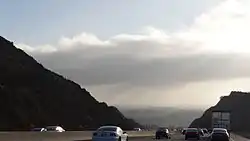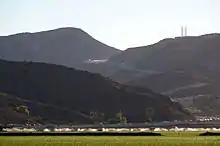Conejo Grade
The Conejo Grade, also known as the Camarillo Grade,[1] is a 7% grade incline with a summit elevation of 841.1 feet (256.4 m). It is a section of US 101 (the Ventura Freeway) linking Thousand Oaks and cities of the Conejo Valley, with Camarillo and the cities on the Oxnard Plain. A Caltrans inspection station for trucks is stationed at the upper terminus of the grade.[2]


Conejo Grade functions as a barrier which separates Ventura County into East County and West County.[3] Historically, the mountain was known for its many jackrabbits and prickly pear cacti. The surrounding area was formed by volcanic eruptions millions of years ago, a rare geological formation in Southern California. The native Chumash people had a trading trail through the pass, and it later served as a trading route for farmers and their wagons down the Conejo Grade to the wharf in Port Hueneme. The grade experienced improvements by the newly established State Highway Department in 1912, when the road measured six miles (9.7 km) long and had 49 curves. Traffic kept increasing and the road was straightened and relocated in 1935. The new road was a mile shorter and only had twelve curves.[4]
History
Originally part of the route of El Camino Real, the steep slope or grade was called the "cuesta del conejo" (slope of the rabbit).[5] Land for the highway was originally part of the Rancho El Conejo, with contributions from Adolfo Camarillo. A road was in place by no later than 1929, as a re-alignment had been done then. Further widening and reduction of blind curves occurred in the 1930s. Caltrans worked on the current grade setup, when the highway was brought to freeway standards in the 1950s.[6] Portions of the original highway continue to receive use by locals as side roads.
A young male mountain lion, P-55, left the Santa Monica Mountains in 2017 by crossing the freeway on the grade during the night. The animal was wearing a tracking collar used by the National Park researchers studying the mountain lions in the Santa Monica Mountains National Recreation Area.[7]
The Hill fire temporarily closed the freeway on November 8, 2018 as Santa Ana Winds pushed the fire to the south towards Newbury Park and California State University Channel Islands. The fire was contained with minimal damage on November 16.[8] The Woolsey Fire started the same day, closed the freeway near Oak Park, grew to over 98,362 acres (39,806 hectares), destroyed an estimated 616 structures and killed 3 people.
References
- "Wildfire cuts swath from Camarillo grade, threatens upscale Newbury Park community". Simi Valley Acorn. Retrieved January 28, 2020.
- HEIE, TROY (February 18, 1998). "Faulty Truck Brakes Blamed in Freak Fatal Crash, CHP Says". Los Angeles Times. Retrieved 17 November 2018.
Its slope of 7% is second only to the Cuesta Grade, a 2.4-mile stretch of U. S. 101 in San Luis Obispo County, according to officials with the California Department of Transportation.
- "Making the Grade". Research Library. Museum of Ventura County. Retrieved March 5, 2019.
- Brant, Cherie (2006). Keys to the County: Touring Historic Ventura County. Ventura County Museum. Pages 133-134. ISBN 978-0972936149.
- See the use of this term in the confession of Reyes Feliz in Daily Alta California, Volume 3, Number 345, 15 December 1852, p.2, col.2 Later from the South.
- Pols, Mary F. (February 11, 1996) "ON THE ROAD: Journeys Along Ventura County's Highways" Los Angeles Times
- Carlson, Cheri (August 7, 2017). "Mountain lion makes rare trek, successfully crossing Highway 101". Ventura County Star. Retrieved 17 November 2018.
- Hersko, Tyler (November 16, 2018). "Investigators point to human activity as cause of Hill Fire; containment at 100 percent". Ventura County Star. Retrieved 17 November 2018.